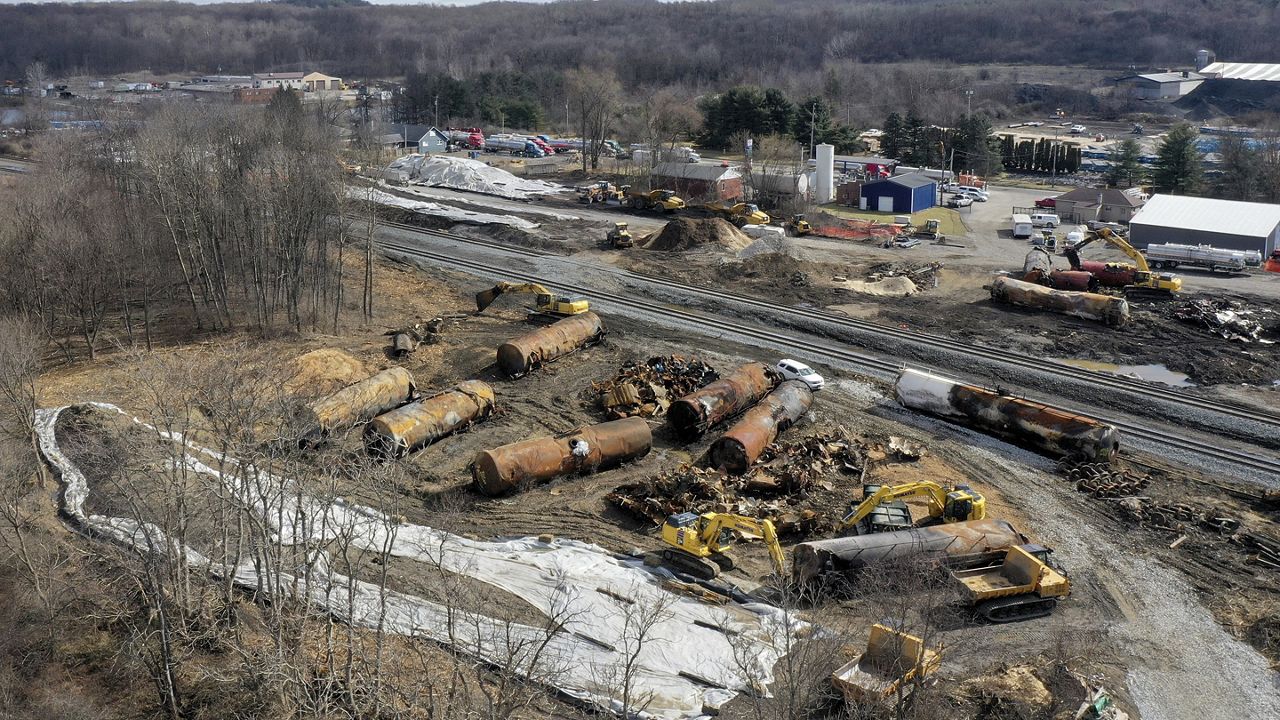OMAHA, Neb. (AP) — A new federal rule finalized Monday aims to ensure first responders can find out what hazardous chemicals are on a train almost immediately after a derailment so they can respond appropriately.
Too often in past disasters like last year's fiery Norfolk Southern derailment in East Palestine, Ohio, firefighters risked their lives trying to extinguish a blaze without knowing the right way to respond. The local fire chief in charge of the response said it took him 45 minutes to learn exactly what was in the 11 burning tank cars on the train, but some firefighters from neighboring departments that came to help said they didn't know what they were dealing with until two hours after the Feb. 3, 2023, crash.
First responders need to know exactly which hazardous materials are on a train so they can look it up in the government's official guidebook and make sure they have the right protective gear and firefighting tools, said Tristan Brown, deputy administrator of the Pipelines and Hazardous Materials Safety Administration agency that proposed the rule.
Knowing what chemical is involved and how much of it is aboard also affects how big of an evacuation zone might be required to protect the public.
“There are so many different types of hazardous materials being transported across the country on any given day — one in 10 goods that move across the United States — and each one, poses unique risks and hazards, certainly to the folks who are running towards a fire,” Brown said. “But certainly as well for anybody who may be living or working in that vicinity.”
The rule was published just one day ahead of the National Transportation Safety Board's final hearing on the East Palestine derailment, where they will discuss exactly what caused that crash and recommend steps to prevent similar disasters.
Train crews have long carried lists of their cargo in the cabs of their locomotives, but in the middle of the chaos after a derailment those engineers and conductors, who might have moved their locomotives miles down the track, can't always be found right away.
That's part of why the largest freight railroads developed an app called AskRail roughly a decade ago that enables firefighters to quickly look up the details of what each train carries. But not every firefighter had the app, and cell phones don't always have a signal strong enough to work in a disaster.
Regulators want the railroads to continue expanding access to that app, including to 911 centers, so information reaches first responders sooner. The railroads have been expanding access over the past year. The Association of American Railroads trade group estimates some 2.3 million first responders now have access to that information as a result of the effort to expand into dispatch centers.
The six biggest railroads also make train cargo information immediately available through the chemical industry's hazardous materials hotlines in the U.S. and Canada known as the CHEMTREC and CANUTEC emergency call centers.
But the new federal rule also applies to the hundreds of smaller railroads that aren't involved in AskRail. Even railroads that only have one or two employees now must have a plan to get the crucial details of their cargo to the local fire department quickly, even if it's as simple as having the fire chief's cell phone number at the ready. Railroads also must test their plan at least once a year.
“In a hazmat incident, firefighters and first responders arriving on scene need to know what kind of hazardous materials are present so they can protect themselves and their communities,” U.S. Transportation Secretary Pete Buttigieg said.
It's not clear how this rule might have changed the outcome in East Palestine, but more information could have helped responding firefighters.
The derailment prompted a nationwide reckoning over railroad safety and prompted Congress to propose changes and regulators like Buttigieg to urge railroads to do more to prevent derailments.
The Federal Railroad Administration has issued various advisories about different aspects of railroad operations, but the reforms in Congress have stalled because Republicans wanted to wait for the final NTSB report and regulators have had only limited success making changes.



